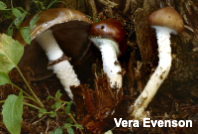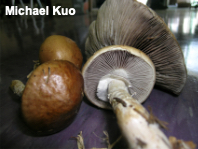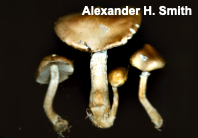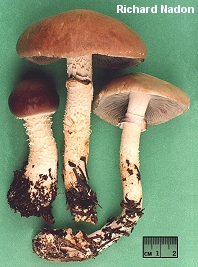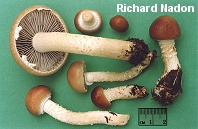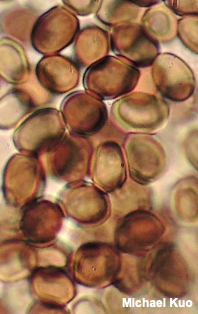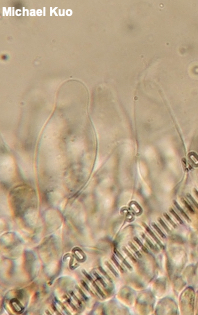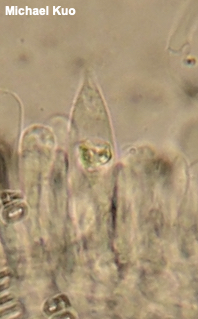| Major Groups > Gilled Mushrooms > Dark-Spored > Stropharioid Mushrooms > Stropharia hornemannii |

|
Stropharia hornemannii [ Basidiomycota > Agaricales > Strophariaceae > Stropharia. . . ] by Michael Kuo Stropharia hornemannii is a large, charismatic Stropharia with a sticky, reddish brown to purple-brown or brown cap and a thick, scaly stem. Like other species of Stropharia it features a dark, purplish brown spore print. Its range is apparently limited to the conifer forests of northern and montane areas. It tends to grow in clusters, and is often found fruiting from well-decayed wood. Stropharia depilata, Psilocybe hornemannii, and Naematoloma hornemannii are synonyms. Thanks to the Sam Mitchel Herbarium of Fungi at the Denver Botanic Gardens for facilitating my study of the Stropharia hornemannii collections cited and described below, and for permission to reproduce the collectors' photos. Description: Ecology: Saprobic; growing alone, scattered, or in clusters on duff and woody debris in boreal and montane forests; often found fruiting from well-decayed wood; summer and fall; widely distributed in northern and montane North America. The illustrated and described collections are from Colorado and Québec. Cap: 3.5–8 cm; convex to broadly conic when young, becoming broadly convex, nearly flat, or broadly bell-shaped; sticky when fresh; bald; sometimes appearing slightly radially streaked; reddish brown to purple-brown or brown when young, but usually fading quickly to tan or pale yellowish brown; often adorned with white veil remnants near the margin. Gills: Broadly attached to the stem or, with age, beginning to pull away from it; close; short-gills frequent; pale gray at first, later purplish gray to purple-black. Stem: 6–10 cm long; 1–1.5 cm thick; equal; dry; with a fairly persistent, skirtlike, white ring featuring a grooved upper surface that becomes dusted with purple-black spore dust; below the ring conspicuously shaggy-scaly with whitish girdles, especially when young; base attached to white mycelial threads. Flesh: White; unchanging when sliced, or turning slightly yellowish. Odor and Taste: Odor somewhat foul, or reminiscent of pumpkin. Taste not distinctive. Spore Print: Dark purple-brown to blackish. Microscopic Features: Spores 12–15 x 6–7.5 µm; ellipsoid; with a small pore; smooth; brown in KOH. Cheilocystidia as leptocystidia; 40–60 x 15–20 µm; widely lageniform to subutriform; thin-walled; hyaline in KOH. Pleurocystidia as chrysocystidia; 50–70 x 10–15 µm; lageniform to utriform; thin-walled; smooth; with or without refractive, yellowish to golden inclusions. Pileipellis an ixocutis; elements 4–5 µm wide, smooth, yellowish in KOH, clamped at septa. REFERENCES: (Fries, 1818) Lundell & Nannfeldt, 1934. (Saccardo, 1887; Kauffman, 1918; Stamets, 1978; Smith, Smith & Weber, 1979; Arora, 1986; Phillips, 1991/2005; Lincoff, 1992; Barron, 1999; Noordeloos, 1999; Roody, 2003; McNeil, 2006; Miller & Miller, 2006; Turdell & Ammirati, 2009; Cripps, Evenson & Kuo, 2016; Siegel & Schwarz, 2016; Baroni, 2017.) Herb. DBG 4772, 18671. This site contains no information about the edibility or toxicity of mushrooms. |
© MushroomExpert.Com |
|
Cite this page as: Kuo, M. (2018, November). Stropharia hornemannii. Retrieved from the MushroomExpert.Com Web site: http://www.mushroomexpert.com/stropharia_hornemannii.html |
